
“So she filled their mouths with dust
And their bones with fever;
Greeted them with cruel lies;
Treated them despiteful-wise;
Meted them calamities
Till they vowed to leave her!”
1903 – Rudyard Kipling’s South Africa
The concept of the Ruger No. 1 and the 450/400 3″ Nitro Express combination originated when the 19th century was spilling over into the 20th century and the British Empire’s presence in Africa still served as the setting for stories of great adventure. The Ruger No.1 is much more related to pith helmets, jungle clearing machete’s and charging cape buffalo than it is to the modern “Two day, fly and drive, stay in a luxury hotel, make sure to bring your checkbook” hunt. In fact, when you hold a Ruger No. 1 in your hands you may find yourself wiping imaginary sweat from your brow with your shirt sleeve and swatting at an imaginary tsetse fly biting at the nap of your sunburned neck…. Bwana.
In 1895, W. J. Jeffery & Co. began assembling single shot rifles based on a Belgium made public domain version of the Farquharson action. I do not know if it was morning or afternoon. Circa 1896[1], Jeffery introduced the cordite loaded 450/400 3″ Nitro Express cartridge, which displaced the earlier and more fragile cased 450/400 3¼” Magnum Nitro Express. The latter, is a cartridge of black powder propellant origins.
At the heart of the Ruger No. 1 is John Farquharson’s 1872 single shot rifle[2]. The form of the No. 1’s two piece stock is traditional Alexander Henry Scottish with modest geometric consideration given to accommodate the use of a scope. There in no denying the rifle’s early Western European lineage.
|
Ruger No.1 Tropical Single-Shot Rifle |
|
| Manufacturer | Ruger Firearms |
| Model | 11324 |
| Type | Under Lever Falling Block |
| Caliber | 450/400 3″ Nitro Express |
| Capacity | 1 |
| Barrel Length | 24“ |
| Rifling | 1:15″ 6 Groove |
| Weight | *8 lbs 1 oz. |
| Overall Length | 40.50“ |
| Stock | Walnut… very nice |
| Hardware | Blued Gloss |
| Length of Pull | 13.50″ |
| Drop at comb | 0.50″ |
| Drop at heel | 0.75″ |
| Rear Sight | Folding Leaf on Quarter Rib |
| Front Sight | Ramped – Brass bead |
| Scope | Ruger Integral Base |
| Trigger Pull | *4 lbs.5 oz. |
| Safety | 2 Position Thumb Safety |
| MSRP | $1242 |
| Online Retail | $940 |
|
* Actual |
|
Chambered for a cartridge of this length, the Ruger’s action allows the No.1 to be very compact and fast handling, even with a 24″ barrel. It is a half foot shorter than a bolt action rifle equivalent. The satin finished walnut on this production gun is beautiful.
Ruger No.1 rifles get a workout at RealGuns. Besides seeing service as solid, accurate and cost effective hunting rifles, their unique design makes them a good fit for wildcat cartridge development. The action is robust, highly adaptive and easy to rebarrel so the extremes of the .358-378 RG and the diminutive .17-357RG are easily accommodated. Additionally, we routinely affix strain gauges to No. 1 rifles for pressure checking duty during handload development.
No, it’s a three, not a four stroke
The Ruger No.1 is an under lever falling block, which sounds a bit… precarious., but the beefy block is located in a positive fashion and it stops falling well short of falling out. Great news for anyone with a vested interest. The lever beneath the trigger guard, the infamous under lever, is released and lowered, allowing the Ruger’s breech block to fall and for a round to be chambered. Below, the lower left frame shows the fallen block protruding from the bottom of the action. Top right frame, the under lever is raised, lifting the breech block so it will contain the cartridge case head.
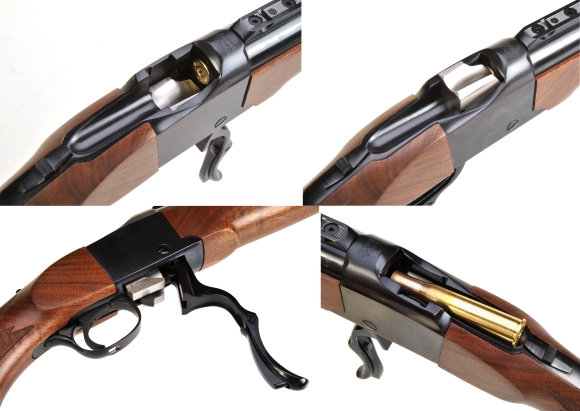
The bottom right frame shows the cartridge after it is ejected. It is my experience that large cartridges will bump into the gun’s tang safety and come to rest in the saddle formed by the lowered breech block. This is probably the best set up as shooters will not be required to manually pull cases from the gun’s chamber or crawl around in the brush looking for empties. Extracted or ejected, an empty casing can be cleared in fractions of a second to open the path for a fresh round… except on message boards where hunting is apparently much more dangerous and shooters apparently lack presence of mind and manual dexterity.
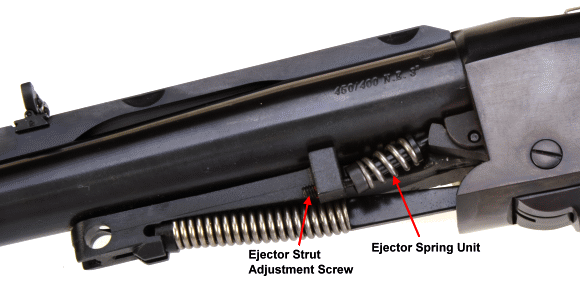
For people who are finicky, and/or have a need to tinker, the Ruger No.1 can be configured to extract or eject and for greater or lesser ejection force. To convert the Ruger No.1 to extract only rather than extract and eject, the Ejector Strut Adjustment Screw is backed out until the Ejector Strut Spring is no longer preloaded and the Ejector Spring Unit is free and can be removed. With the unit in place, the Ejector Strut Adjustment Screw can be turned out or in to decrease or increase, respectively, the Ejector Spring preload. Caution. Too much preload will bind the action so, regardless the changes made, a full lever stoke ops check is essential. Before attempting any of this, read the manual… yeah, that little white booklet that is packaged with every firearm sold.
The mystery of the Alexander Henry forearm… It’s a bottle opener

The Alexander Henry style forearm is frequently the topic of discussion – specifically the groove just aft of the forend. No, it is not a schnabel, as often seen on German and Austrian firearms. James Barsness did a great job covering the subject of schnabelism in the May/June 2011 issue of Sports Afield. Ruger defines the forearm as an Alexander Henry nineteenth century design and their company support group indicates that the groove neither serves, or served, a functional purpose. My sense is that European nuance work almost always serves a purpose to the extent that functional purpose is often buried within ornate design. My sense is not that the groove was not used for shooting sticks; the angle would be wrong. I believe the groove was used as a tie down point, a surface that would not allow a rope of sorts to slip forward and off. While absolutely no foundation for this thought exists, it’s my theory and I’m sticking with it.
The 450/400 3″ Magnum Nitro Express… AKA the .400 Jeffery
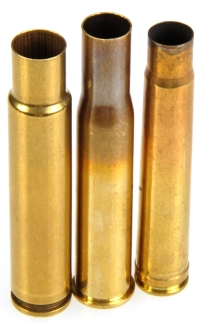
As the power monkey in the middle, pictured between the 450 Rigby and 375 H&H, prior to the introduction of the 375 H&H the 450/400 3″ NE was a popular all around African game cartridge. As such, it was used on everything from antelope to elephant. Even today, with a 400 grain bullet with a muzzle velocity of 2,150 fps, it is often promoted as an ideal cartridge for cape buffalo[3]. Bullet diameter is not lacking in ambiguity. Ammunition loaded specifically for the Ruger has a 0.410″ diameter bullet. Ammunition from Hornady is loaded with 0.410″ bullets, Kynoch loads 0.408″ and 0.410″. A-Square loads 0.409″. The current official CIP specification is 0.400″ bore diameter and 0.410 groove diameter.
A 450/400 3″ Nitro Express cannot be fired in a 450/400 3¼” chamber for more reasons than just the ¼” component difference in their names. The 3″ cartridge’s shoulder is located 0.100″ farther forward at 2.400″ and its headspace determining rim is 0.023″ thicker. The 3¼” cartridge has a 124 grain capacity, compared to the 3″ case’s 115 grains. The modern 3¼” operates at 4,000 PSI greater maximum pressure[3][4].
Ruger did chamber a special edition Boddington No.1 for the 450/400 3¼” Magnum Nitro Express in 2008, however, the current production Model No. 1 Tropical is chambered for the 3″ cartridge. Why is this change a good thing? Because 3″ ammunition, cases and reloading dies carry non-eyebrow raising prices, where 3¼” ammo and brass are scarce and expensive and reloading dies are of the $300/set, six month wait variety. I am waiting for Ruger to release a commemorative “Joe” model. Waiting. Still waiting…
The 450/400 3″ in context with big boy rounds…
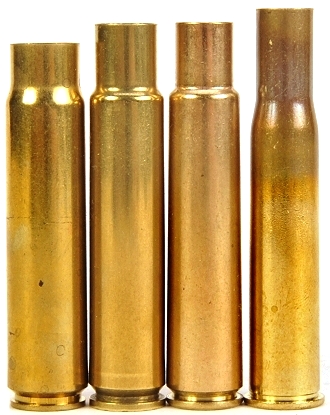 Left to right, or right to left is you are standing on your head while reading this: 500 Jeffery, 450 Rigby, 416 Rigby, 450/400 3″ NE. The 450/400, with its long neck, was originally intended for use with long strand cordite propellant. It is also rimmed for use in double and single shot rifle applications.
Left to right, or right to left is you are standing on your head while reading this: 500 Jeffery, 450 Rigby, 416 Rigby, 450/400 3″ NE. The 450/400, with its long neck, was originally intended for use with long strand cordite propellant. It is also rimmed for use in double and single shot rifle applications.
The 450/400 3″ NE is the result of necking down and shortened a 450 3¼” Nitro Express case, with the “/.400” representing the new bore size. The 450/400 3″ NE is described as a lighter recoiling alternative to some of the other cartridges noted. A good thought, as a bout with the Jeffery had me peeling my retinas off the inside lenses of my shooting glasses. With 25% greater powder capacity and 33% greater bullet weight than the 375 H&H, it doesn’t exactly strike me as a lightweight.
I’ve read speculative opinion that the 450/400 3″ NE lost its appeal as the 375 H&H became more prevalent. I’d hazard a guess that the cause was not the 375 H&H’s superior ballistic performance, as much as the 375 H&H’s rimless configuration and its ability to function in inexpensive magazine rifles. If you don’t believe a little thing like a rim can make that much of a difference, when was the last time you saw a .375 Flanged Magnum Nitro Express, the rimmed version of the .375 H&H?
Handloading the 450/400 3″ Nitro Express
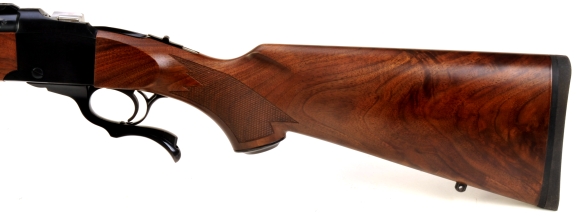
As you can see, this is a static image of the Ruger No.1. Not a hint of rearward movement under recoil. You may have also noticed that no images of bullets appear anywhere within this tangled text. Proper bullets, size and construction, are on the way and they will star in the follow on production “Part II – Handloading the 450/400 3″ Nitro Express”. Why the picture of the buttstock? I thought, as I can’t do anything else at the moment, I would show you that the production walnut is exceptional on both sides of this rifle.
For those of you who will email to advise the .450/400 3″ NE found a great deal of use as a hunting rifle in the hands of India’s maharajas, nawabs, and you know who you are, I’ll head those off with a stanza from William Blake’s “The Tyger” –
“What the hammer? what the chain,
In what furnace was thy brain?
What the anvil? what dread grasp,
Dare its deadly terrors clasp!”
Ruger’s No. 1 Tropical 450/400 3″ NE Part I
Ruger’s No. 1 Tropical 450/400 3″ NE Part II

Email Notification